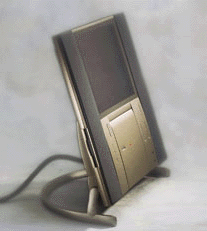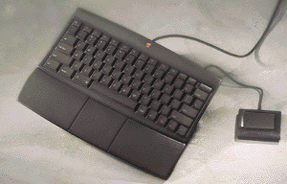 The
20th Anniversary Macintosh has to be one of the most innovative
designs Apple has ever come up with. Returning to their roots
as a leader in pioneering technology, Apple has created a machine
unlike any other. But just like many cool-looking machines before
it, the technology came at a price. Originally slated to cost
$9000, it went down to $7500 upon introduction in spring of 1997.
As you have probably guessed, this machine was supposed to commemorate
the 20th anniversary of Apple Computer, Inc. even though it was
released an entire year later (unless they interpreted the company's
incorporation date as the its birth). Anyway, this machine is
a marvel. Based on a 250 MHz PowerPC 603e processor, it has a
12.1" active-matrix LCD display capable of 24-bit color
at 800x600 pixel resolution. Since this Mac does not have the
limited power supply of the similar PowerBook 3400 which its
internal design resembles, it is able to display at such a high
bit depth at such a relatively high resolutions on an active-matrix
display. The result is incredible, a beautiful LCD display only
paralleled by Apple's recently released Apple Studio Display
monitor. The Alchemy logic board is the same one used in the
PowerMac 6400, and is as expandable as that model taking all
standard PCI slots. Another dream-like feature of the 20th Anniversary
Mac is the sound system/power supply. Apple has cleverly developed
a seperate power supply that is also an incredible subwoofer
designed by Bose. Bose also designed the speakers on the sides
of the machine, incorporating the most advanced technology the
company is now creating. Alos deserving honorable mention are
the drives and peripherals. Apple installed a side-mounted (vertical)
CD-ROM that runs at 4x, the fastest currently available for side-mounded
CD-ROM drives. The floppy drive is almost undistiguishable, hiding
on one side of the machine next to one of the speaker grills.
The only thing that leaves me wondering "Why'd they do that?"
is the interesting but out-of-place keyboard (shown below). Similar
to PowerBook keyboards, it has smaller function keys and no extended
keyboard functions (like the numeric keypad, etc.). It also includes
a trackpad. Even so, this is one really cool machine that had
users drooling when they saw it for the first time. By the way,
if anybody would like to donate one of these babies to the Museum,
I'd be more than happy to take it. The
20th Anniversary Macintosh has to be one of the most innovative
designs Apple has ever come up with. Returning to their roots
as a leader in pioneering technology, Apple has created a machine
unlike any other. But just like many cool-looking machines before
it, the technology came at a price. Originally slated to cost
$9000, it went down to $7500 upon introduction in spring of 1997.
As you have probably guessed, this machine was supposed to commemorate
the 20th anniversary of Apple Computer, Inc. even though it was
released an entire year later (unless they interpreted the company's
incorporation date as the its birth). Anyway, this machine is
a marvel. Based on a 250 MHz PowerPC 603e processor, it has a
12.1" active-matrix LCD display capable of 24-bit color
at 800x600 pixel resolution. Since this Mac does not have the
limited power supply of the similar PowerBook 3400 which its
internal design resembles, it is able to display at such a high
bit depth at such a relatively high resolutions on an active-matrix
display. The result is incredible, a beautiful LCD display only
paralleled by Apple's recently released Apple Studio Display
monitor. The Alchemy logic board is the same one used in the
PowerMac 6400, and is as expandable as that model taking all
standard PCI slots. Another dream-like feature of the 20th Anniversary
Mac is the sound system/power supply. Apple has cleverly developed
a seperate power supply that is also an incredible subwoofer
designed by Bose. Bose also designed the speakers on the sides
of the machine, incorporating the most advanced technology the
company is now creating. Alos deserving honorable mention are
the drives and peripherals. Apple installed a side-mounted (vertical)
CD-ROM that runs at 4x, the fastest currently available for side-mounded
CD-ROM drives. The floppy drive is almost undistiguishable, hiding
on one side of the machine next to one of the speaker grills.
The only thing that leaves me wondering "Why'd they do that?"
is the interesting but out-of-place keyboard (shown below). Similar
to PowerBook keyboards, it has smaller function keys and no extended
keyboard functions (like the numeric keypad, etc.). It also includes
a trackpad. Even so, this is one really cool machine that had
users drooling when they saw it for the first time. By the way,
if anybody would like to donate one of these babies to the Museum,
I'd be more than happy to take it. |
 The
20th Anniversary Macintosh has to be one of the most innovative
designs Apple has ever come up with. Returning to their roots
as a leader in pioneering technology, Apple has created a machine
unlike any other. But just like many cool-looking machines before
it, the technology came at a price. Originally slated to cost
$9000, it went down to $7500 upon introduction in spring of 1997.
As you have probably guessed, this machine was supposed to commemorate
the 20th anniversary of Apple Computer, Inc. even though it was
released an entire year later (unless they interpreted the company's
incorporation date as the its birth). Anyway, this machine is
a marvel. Based on a 250 MHz PowerPC 603e processor, it has a
12.1" active-matrix LCD display capable of 24-bit color
at 800x600 pixel resolution. Since this Mac does not have the
limited power supply of the similar PowerBook 3400 which its
internal design resembles, it is able to display at such a high
bit depth at such a relatively high resolutions on an active-matrix
display. The result is incredible, a beautiful LCD display only
paralleled by Apple's recently released Apple Studio Display
monitor. The Alchemy logic board is the same one used in the
PowerMac 6400, and is as expandable as that model taking all
standard PCI slots. Another dream-like feature of the 20th Anniversary
Mac is the sound system/power supply. Apple has cleverly developed
a seperate power supply that is also an incredible subwoofer
designed by Bose. Bose also designed the speakers on the sides
of the machine, incorporating the most advanced technology the
company is now creating. Alos deserving honorable mention are
the drives and peripherals. Apple installed a side-mounted (vertical)
CD-ROM that runs at 4x, the fastest currently available for side-mounded
CD-ROM drives. The floppy drive is almost undistiguishable, hiding
on one side of the machine next to one of the speaker grills.
The only thing that leaves me wondering "Why'd they do that?"
is the interesting but out-of-place keyboard (shown below). Similar
to PowerBook keyboards, it has smaller function keys and no extended
keyboard functions (like the numeric keypad, etc.). It also includes
a trackpad. Even so, this is one really cool machine that had
users drooling when they saw it for the first time. By the way,
if anybody would like to donate one of these babies to the Museum,
I'd be more than happy to take it.
The
20th Anniversary Macintosh has to be one of the most innovative
designs Apple has ever come up with. Returning to their roots
as a leader in pioneering technology, Apple has created a machine
unlike any other. But just like many cool-looking machines before
it, the technology came at a price. Originally slated to cost
$9000, it went down to $7500 upon introduction in spring of 1997.
As you have probably guessed, this machine was supposed to commemorate
the 20th anniversary of Apple Computer, Inc. even though it was
released an entire year later (unless they interpreted the company's
incorporation date as the its birth). Anyway, this machine is
a marvel. Based on a 250 MHz PowerPC 603e processor, it has a
12.1" active-matrix LCD display capable of 24-bit color
at 800x600 pixel resolution. Since this Mac does not have the
limited power supply of the similar PowerBook 3400 which its
internal design resembles, it is able to display at such a high
bit depth at such a relatively high resolutions on an active-matrix
display. The result is incredible, a beautiful LCD display only
paralleled by Apple's recently released Apple Studio Display
monitor. The Alchemy logic board is the same one used in the
PowerMac 6400, and is as expandable as that model taking all
standard PCI slots. Another dream-like feature of the 20th Anniversary
Mac is the sound system/power supply. Apple has cleverly developed
a seperate power supply that is also an incredible subwoofer
designed by Bose. Bose also designed the speakers on the sides
of the machine, incorporating the most advanced technology the
company is now creating. Alos deserving honorable mention are
the drives and peripherals. Apple installed a side-mounted (vertical)
CD-ROM that runs at 4x, the fastest currently available for side-mounded
CD-ROM drives. The floppy drive is almost undistiguishable, hiding
on one side of the machine next to one of the speaker grills.
The only thing that leaves me wondering "Why'd they do that?"
is the interesting but out-of-place keyboard (shown below). Similar
to PowerBook keyboards, it has smaller function keys and no extended
keyboard functions (like the numeric keypad, etc.). It also includes
a trackpad. Even so, this is one really cool machine that had
users drooling when they saw it for the first time. By the way,
if anybody would like to donate one of these babies to the Museum,
I'd be more than happy to take it. 